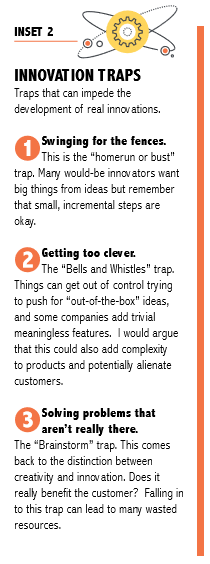The Relationship between Creativity, Innovation and Entrepreneurship: INNOVATION
Dr. David Price | Washburn University
INNOVATION
In the last edition of TK Business Magazine, I discussed creativity and its relationship with innovation and entrepreneurship, and the differences between these concepts. However, creativity is just the beginning. Creativity is the fuel to ignite new ideas and new ways of thinking. But the real question is whether these new ideas matter to customers. This is where creative ideas can transform into a true innovation.
WHY IS INNOVATION IMPORTANT?
In a McKinsey survey of hundreds of CEOs, innovation was rated among the top five areas that will increase in importance in the next five years. Finding employees who embrace creativity and innovation was also one of the top five challenges, suggesting it is a quality that has been deficient in the workforce. A survey from PwC Global found that 84 percent of executives say innovation is extremely important to their company’s growth strategy, but only 6 percent are happy with their innovation performance. The United States has long been considered the world leader in innovation, yet we have seen a reduction in this global dominance. For the first time in 2010, 51 percent of all U.S. patents were awarded to non-U.S. companies.
WHAT IS INNOVATION AND HOW IS IT DIFFERENT FROM CREATIVITY?
Examples of creativity surround us, whether a new product idea or an artists’ new masterpiece. Many of these pursuits may be creative and different, but if they are not useful to people (particularly potential customers), then they cannot be considered truly innovative. True innovation is the conversion of ideas from the creative process into a benefit.
There also remains a distinction between innovation and invention. While “invention” is often the result of a creative process, it is no guarantee of usefulness and certainly profitability. The US patent office is littered with creative and imaginative output that has never made it to market or had any significant return on investment (research suggests that only 2 percent of all patents realize profits).
Therefore, an invention still needs to have benefit. A man named Gary Kildall built the first personal computer operating system, the CP/M, in the late 1970s. However, Bill Gates and his expert business acumen took an imitation with additional features, DOS, into the standard operating system for the IBM PC and later for 90 percent of all PCs. Kildall was the inventor, Gates the innovator. While inventions start with a creative process, the innovator turns the result into a product, service, or process that proposes a benefit and has impact for others.
TYPES OF INNOVATION
Innovation can happen in a big way. Most of us have heard of the great ideas and the famous people behind them (e.g. Steve Jobs and the iPhone). But there are also other types of innovations that can have an impact for firms, and these categories help us approach innovation from the perspective of our own unique businesses. [See inset 1.]
The lesson here is that we don’t have to invent something that is totally new; we need to see things in new ways, with different uses, or create new combinations. However, this process is not always easy or cheap, as innovation can require time and resources.
MAKING YOUR CREATIVITY MORE USEFUL
The first step in innovation is developing many ideas through the creative process. Ideas can be a well-developed invention or simply “hunches” formed from observation or experience. In either case, these must be filtered into more promising forms of business ideas. It is important to note that most of our ideas will never come to fruition. Some well-known research by Stevens and Burley found that for every 3000 raw ideas gathered by firms, on average only two are eventually launched and only one of those is successful. So we should try to understand early on which ideas have a better chance of succeeding than others.
We can eliminate bad ideas by evaluating them based on two criteria: impact and feasibility. Impact will allow you to ask questions such as will this potential new idea have the effect on my business I am looking for? Is that impact profit? Is it simply to keep up with competition and maintain market share? If the answer to any of your questions is no, then you should look to the next idea before committing resources to its research and development. Second, each idea should be judged on its feasibility. While you may believe you have developed a fantastic idea that customers will love, if you don’t have the resources to develop it (time, money, knowledge, skill), then it probably is not worth the effort to move forward as the costs will outweigh the returns.
Traps
Traps that can impede the development of real innovations.






